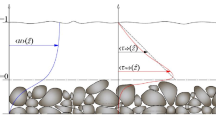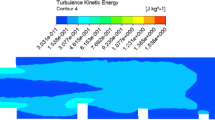Abstract
The mechanical energy balance and energy loss have attracted significant attention in the literature. The general form of the energy equation has been previously presented; however, in most applications the simplified 1-D form without considering the details of turbulent flows has been applied. In this study, a form of the total mechanical energy balance equation for 3-D turbulent flows in open-channels is investigated in which all turbulence parameters involving the effects of the secondary currents can be evaluated by using equalizations that have not previously been applied to the total mechanical energy equation and RANS turbulence models. Based on the equalizations, the existing correlations in the total energy equation are replaced with a combination of mean flow variables and known turbulence parameters from turbulent flow numerical simulations. Therefore, the details of the total mechanical energy balance for 3-D turbulent flows in open-channels with different geometries can be analyzed using the proposed methodology. Then, an explicit relationship for the energy loss, usually determined empirically, is derived from the developed energy equation. In order to investigate the utilization of the analytical relationships, 3-D numerical simulations are performed using OpenFOAM to solve the Navier–Stokes equations with the RSM turbulence model. By applying the analytical relationship and the simulation results, the mechanical energy losses are obtained and compared with the energy losses from the previous energy equations, the effect of the various parameters on the total mechanical energy balance is studied, the role of wall resistance in the mechanical energy is investigated and efforts are made to identify the parameters affecting the local and friction losses of turbulent flows in the irregular open-channels. Finally, a deeper understanding of the details of the energy transformation process and the mechanical energy loss of the complex flows is achieved.













Similar content being viewed by others
Notes
Reynolds stress model.
References
Henderson FM (1966) Open channel flow. Macmillan Publishing Co, New York
Chow VT (1959) Open channel hydraulics. Mcgraw-Hill, New York
FouladiNashta C, Garde RJ (1988) Subcritical flow in rigid-bed open channel expansions. J Hydraul Res 26(1):49–65
Smith CD, Yu JNG (1966) Use of baffles in open channel expansions. J Hydraul Div 92(2):1–17
Skogerboe GV, Austin LH, Bennel RS (1971) Energy loss analysis for open channel expansion. J Hydraul Div 95(10):1719–1735
Haque A (2008) Some characteristics of open channel transition flow. M.Sc. Thesis, Civil Engineering, Concordia University
Najafi-Nejad-Nasser A, Li SS (2015) Reduction of flow separation and energy head losses in expansions using a hump. J Irrig Drain Eng. https://doi.org/10.1061/(ASCE)IR.1943-4774.0001034
Najmeddin S, Li SS (2016) Numerical study of reducing the flow separation zone in short open-channel expansions by using a hump. J Irrig Drain Eng. https://doi.org/10.1061/(ASCE)IR.1943-4774.0001034
Basak BC, Alauddin M (2010) Efficiency of an expansive transition in an open channel subcritical flow. DUET J 1(1):27–32
Førde OØ (2012) Analysis of the turbulent energy dissipation. M.Sc. Thesis, Norwegian University of Science and Technology
Artichowicz W, Sawicki JM (2017) Determination of mechanical energy loss in steady flow by means of dissipation power. Arch Hydro-Engineering Environ Mech 64(2):73–85
Landau LD and Lifshitz EM (1987) Fluid mechanics, Second Edition
Liu S, Xue J, Fan M (2013) On the calculation of mechanical energy loss for steady pipe flow of homogenous incompressible fluid. J Hydrodyn 25(6):912–918
Liu S, Fan M, Xue J (2014) The mechanical energy equation for total flow in open channels. J Hydrodyn 26(3):416–423
Liu S, Liao TT, Luo QS (2015) Numerical simulation of turbulent flow behind sluice gate under submerged discharge conditions. J Hydrodyn 27(2):257–263
Liu S, Zhao Q, Luo Q (2019) The total flow control equations and the characteristics of unsteady gradually varied flow in open channels. J Hydrodyn 31(1):177–185
Liu S, Xue J (2016) Theoretical analysis and numerical simulation of mechanical energy loss and wall resistance of steady open channel flow. J Hydrodyn 28(3):489–496
Nezu I, Nakagawa H (1993) Turbulence in open-channel flows. Routledge, England
Mahmoudi M, Banihashemi MA (2022) Analytical and numerical investigation of mechanical energy balance and energy loss of three-dimensional steady turbulent flows in open-channels. J Hydrol Hydromech 70(2):222–233. https://doi.org/10.2478/johh-2022-0011
Mahmoudi M, Banihashemi MA (2022) Theoretical analysis and numerical simulation of mechanical energy loss of turbulent flows in open-channel expansions. J Hydraul Struct 7(4):26–44. https://doi.org/10.22055/jhs.2022.40210.1202
Hinze JO (1975) Turbulence. McGraw-Hill Publishing Co., New York
Wilcox DC (1998) Turbulence modeling for CFD. DCW industries, Canada
Tennekes H, Lumley JL (1972) A first course in turbulence. MIT press, Cambridge
Gibson MM, Rodi W (1989) Simulation of free surface effects on turbulence with a Reynolds stress model. J Hydraul Res 27(2):233–244
Versteeg HK and Malalasekera W (2007) An introduction to computational fluid dynamics, Second Edition
Celik I, Rodi W (1984) Simulation of free-surface effects in turbulent channel flows. Physicochem Hydrodyn 5(3–4):217–227
Zhou JG (1995) Velocity-depth coupling in shallow-water flows. J Hydraul Eng 121(10):717–724
Merkel A (2019) Modeling a Xenon Tank, its heat convection and in-orbit behavior with a 2D CFD Method. RWTH Aachen university
Greenshields CJ (2021) OpenFOAM user guide, 2018
Author information
Authors and Affiliations
Corresponding author
Additional information
Publisher's Note
Springer Nature remains neutral with regard to jurisdictional claims in published maps and institutional affiliations.
Appendix 1
Appendix 1
The PIMPLE algorithm is a combination of SIMPLE (Semi-Implicit Method for Pressure-Linked Equations) and PISO (Pressure Implicit with Splitting of Operator). All these algorithms are iterative solvers (PISO and PIMPLE are both used for transient cases; whereas, SIMPLE is used for steady-state cases). The PIMPLE algorithm is as SIMPLE algorithm for every time step, in which outer correctors are the iterations, and once converged will move on to the next time step until the solution is complete. Better stability is obtained from PIMPLE in comparison to PISO for this reason, especially when dealing with large time steps where the maximum Courant number may be more than 1, or when the nature of the solution is inherently unstable.
In other words, in PIMPLE algorithm, for each time step, a steady state solution that converges is sought after, using a specified number of correction loops. After that, all other transport equations are solved. It would be equal to the PISO algorithm with the specified number of correction loops. However following this, the algorithm loops back over the entire time step and solves the PISO algorithm again with a new initial guess [28, 29]. A simplified flowchart of the algorithm is shown in Fig.
14. As mentioned earlier, the advantage of the use of the PIMPLE algorithm is that the Courant number can be much larger than 1 and no under-relaxation is required for a stable solution. This allows for larger time steps, but the computational effort for each time step is more than PISO algorithm.
Rights and permissions
About this article
Cite this article
Mahmoudi, M., Banihashemi, M.A. Analysis of the details of total mechanical energy balance and turbulent flow characteristics in irregular open-channels. Environ Fluid Mech 22, 1187–1209 (2022). https://doi.org/10.1007/s10652-022-09885-y
Received:
Accepted:
Published:
Issue Date:
DOI: https://doi.org/10.1007/s10652-022-09885-y





